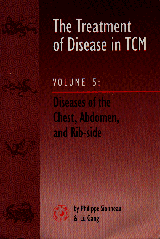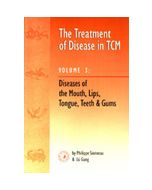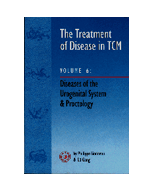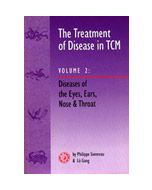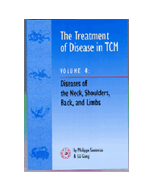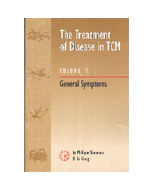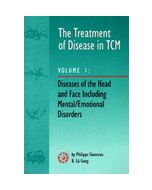We use cookies to make your experience better. To comply with the new e-Privacy directive, we need to ask for your consent to set the cookies. Learn more.
The Treatment Of Disease In TCM Vol. 5:Diseases of the Chest, Abdomen & Rib-side
This book is the fifth volume in this series on the clinical practice of medicine. In it, students and practitioners will find the disease causes and mechanisms, patterns, acupuncture, and Chinese herbal treatment of three dozen or more diseases affecting the chest, abdomen, and rib-side. It includes an amazingly wide range of diseases and symptoms including hiccup, intercostal neuralgia, asthma, appendicitis, and other conditions not covered elsewhere in the English language literature.
An excerpt from The Treatment of Disease in TCM, Vol. 5: Diseases of the Chest, Abdomen & Rib-side
Chest Pain
Chest pain refers to pain occurring in any part of the chest. The chest corresponds to the upper burner and contains the heart and lungs. Therefore, in most cases, chest pain is a manifestation of lung and/or heart disease. Chest pain as discussed below does not include that from coughing and suspended rheum. These are discussed in their own chapters below.
Disease causes, mechanisms:
1. Heat evils congesting in the lungs
The heat in this case is often from warm or heat evils which invade the body externally and then shift inward to congest in the lungs. This heat may cook the fluids within the lung into phlegm, leading to obstruction of the airways and thus impaired depurative downbearing of the lungs. If this heat binds with such phlegm, it may become even more exuberant. This exuberant heat can then damage the network vessels. If this combination of phlegm and heat is bad enough to putrefy the flesh of the lungs, this may result in pulmonary abscess. All such obstruction, damage, and pulmonary abscess can block the free flow of the qi and blood, thus causing pain in the affected area. Since the chest is where the lungs are located, there is pain in the chest.
2. Heart qi vacuity
Heart qi vacuity can be the result of overthinking taxation, constitutional insufficiency, aging, enduring disease, and overdose or enduring use of either sweat-promoting or precipitating medicinals. "The heart governs the blood" and "the qi is the commander of the blood." Therefore, if heart qi becomes vacuous and weak, the movement of the blood by and in the heart will become inhibited. Such a combination of qi vacuity and inhibited movement of the blood in the heart may well give rise to obstruction of the network vessels of the heart, thus causing pain there. Because the heart is located in the chest, therefore, lack of free flow in the heart typically manifests as chest pain.
3. Heart yang vacuity
Heart yang vacuity usually evolves from a worsening of heart qi vacuity. Chest pain due to heart yang vacuity is due to a combination of three factors. First, if there is heart yang vacuity, there must be a heart qi vacuity. Since it is the heart qi which propels the movement of the blood, heart qi vacuity may fail in this duty. As it is said:
"The qi moves the blood. If the qi moves, the blood moves. If the qi stops, the blood stops."
Therefore, heart qi vacuity may easily lead to blood stasis. Secondly, heart yang vacuity implies a lack of righteous warmth. Cold is constricting and congealing by nature. Therefore, if there is a heart yang vacuity, this may cause congelation and stagnation of the qi and blood in the chest. And thirdly, "the blood and body fluids move together." If heart qi is too weak to move the blood, it will also be too weak to move body fluids. These will then collect and accumulate, transforming into dampness. If dampness endures, it will congeal into phlegm. Once produced, such phlegm will further impede the free flow of qi and blood, thus worsening this whole scenario. Since there is no free flow, there is pain.
4. Heart vessel impediment & obstruction
Impediment and obstruction of the heart vessels can occur if there is either or some combination of blood stasis, phlegm stasis, or cold congelation. Blood stasis may be the result of heart qi vacuity, heart yang vacuity, or heart blood vacuity due to overthinking taxation, aging, constitutional insufficiency, or enduring disease. Phlegm stasis may be due to excessive consumption of fatty, sweet foods that leads to internal accumulation of phlegm dampness. This may then flow up into the heart vessels, stagnating. Cold congelation usually develops from external invasion of cold and dampness of the heart vessels. Often, there is complicating heart yang vacuity allowing for such invasion. If this impediment and obstruction is severe enough to cause stagnation and stasis of the qi and blood, there will be chest pain.
5. Dual vacuity of qi & blood
Dual vacuity of the qi and blood mainly develops from overthinking taxation, enduring disease, or aging. Qi is the commander of the blood. This means it is qi's duty to move and propel the blood. As we have seen above, if there is qi vacuity, there may not be enough qi to move the blood, hence it becomes static. Conversely, the blood is supposed to fill and nourish the blood vessels. The blood vessels can only function when they receive sufficient nourishment from the blood. Therefore, blood vacuity often and easily leads to blood stasis. If the blood becomes static, this will impede the free flow of qi. Then there will be both qi stagnation and blood stasis. Thus there is chest pain.
6. Yin vacuity coupled with effulgent fire
Yin vacuity resulting in chest pain commonly results from the invasion of a warm disease which then excessively consumes yin fluids. However, overthinking taxation, enduring disease, and excessive sexual activity can all contribute to the production of such a yin vacuity.
"The lungs are the delicate viscus. They like moisture and dislike dryness."
When lung yin is vacuous, the lungs lack moisture and fail their duty of depurative downbearing. This leads to inhibition of the qi dynamic or mechanism in the chest. Yin is supposed to check yang. If there is a yin vacuity, yang may become exuberant, engendering heat or even giving rise to effulgent fire. If this heat or fire burns and damages the network vessels of the lungs, there will be chest pain.
7. Liver fire harassing the heart
Liver fire exuberance is typically due to emotional disturbance, such as anger or depression. Depression may transform into fire, while anger can trigger the ascension of liver fire. This is because "all of the seven affects when extreme transform into fire" and "anger leads the qi to rise." When liver fire is transmitted to the heart according to five phase theory, chest pain appears.
CONTENTS
Chest pain
Chest Oppression
Vexatious Heat in the Chest
Sweating on the Chest
Coughing
Coughing of Blood
Hasty Panting
Wheezing
Shortage of Qi
Sneezing
Heart Palpitations
Rib-side pain
Rib-side Distention
Axillary Tidal Dampness
Armpit Odor
Dysphagia Occlusion
Yawning
Stomach Duct Pain
Lesser Abdominal Pain
Lower Abdominal Pain
Periumbilical Pain
Abdominal Chill
Abdominal Fullness
Abdominal Distention
Drum Distention
Borborygmus
Hiccup
Belching
Acid Regurgitation
Clamoring Stomach
Nausea
Vomiting
Vomiting of Blood
Poor Appetite
Increased Intake with Rapid Hungering
Drowsiness and Fatigue After Eating.
| Summary | Philippe Sionneau & Lu Gang |
|---|---|
| Author | Philippe Sionneau & Lu Gang |
| Publication Date | 1 Jan 1970 |
| Publisher | Blue Poppy Press |
| Number of Pages | 400 |
| Book Format | Softback |
An excerpt from The Treatment of Disease in TCM, Vol. 5: Diseases of the Chest, Abdomen & Rib-side
Chest Pain
Chest pain refers to pain occurring in any part of the chest. The chest corresponds to the upper burner and contains the heart and lungs. Therefore, in most cases, chest pain is a manifestation of lung and/or heart disease. Chest pain as discussed below does not include that from coughing and suspended rheum. These are discussed in their own chapters below.
Disease causes, mechanisms:
1. Heat evils congesting in the lungs
The heat in this case is often from warm or heat evils which invade the body externally and then shift inward to congest in the lungs. This heat may cook the fluids within the lung into phlegm, leading to obstruction of the airways and thus impaired depurative downbearing of the lungs. If this heat binds with such phlegm, it may become even more exuberant. This exuberant heat can then damage the network vessels. If this combination of phlegm and heat is bad enough to putrefy the flesh of the lungs, this may result in pulmonary abscess. All such obstruction, damage, and pulmonary abscess can block the free flow of the qi and blood, thus causing pain in the affected area. Since the chest is where the lungs are located, there is pain in the chest.
2. Heart qi vacuity
Heart qi vacuity can be the result of overthinking taxation, constitutional insufficiency, aging, enduring disease, and overdose or enduring use of either sweat-promoting or precipitating medicinals. "The heart governs the blood" and "the qi is the commander of the blood." Therefore, if heart qi becomes vacuous and weak, the movement of the blood by and in the heart will become inhibited. Such a combination of qi vacuity and inhibited movement of the blood in the heart may well give rise to obstruction of the network vessels of the heart, thus causing pain there. Because the heart is located in the chest, therefore, lack of free flow in the heart typically manifests as chest pain.
3. Heart yang vacuity
Heart yang vacuity usually evolves from a worsening of heart qi vacuity. Chest pain due to heart yang vacuity is due to a combination of three factors. First, if there is heart yang vacuity, there must be a heart qi vacuity. Since it is the heart qi which propels the movement of the blood, heart qi vacuity may fail in this duty. As it is said:
"The qi moves the blood. If the qi moves, the blood moves. If the qi stops, the blood stops."
Therefore, heart qi vacuity may easily lead to blood stasis. Secondly, heart yang vacuity implies a lack of righteous warmth. Cold is constricting and congealing by nature. Therefore, if there is a heart yang vacuity, this may cause congelation and stagnation of the qi and blood in the chest. And thirdly, "the blood and body fluids move together." If heart qi is too weak to move the blood, it will also be too weak to move body fluids. These will then collect and accumulate, transforming into dampness. If dampness endures, it will congeal into phlegm. Once produced, such phlegm will further impede the free flow of qi and blood, thus worsening this whole scenario. Since there is no free flow, there is pain.
4. Heart vessel impediment & obstruction
Impediment and obstruction of the heart vessels can occur if there is either or some combination of blood stasis, phlegm stasis, or cold congelation. Blood stasis may be the result of heart qi vacuity, heart yang vacuity, or heart blood vacuity due to overthinking taxation, aging, constitutional insufficiency, or enduring disease. Phlegm stasis may be due to excessive consumption of fatty, sweet foods that leads to internal accumulation of phlegm dampness. This may then flow up into the heart vessels, stagnating. Cold congelation usually develops from external invasion of cold and dampness of the heart vessels. Often, there is complicating heart yang vacuity allowing for such invasion. If this impediment and obstruction is severe enough to cause stagnation and stasis of the qi and blood, there will be chest pain.
5. Dual vacuity of qi & blood
Dual vacuity of the qi and blood mainly develops from overthinking taxation, enduring disease, or aging. Qi is the commander of the blood. This means it is qi's duty to move and propel the blood. As we have seen above, if there is qi vacuity, there may not be enough qi to move the blood, hence it becomes static. Conversely, the blood is supposed to fill and nourish the blood vessels. The blood vessels can only function when they receive sufficient nourishment from the blood. Therefore, blood vacuity often and easily leads to blood stasis. If the blood becomes static, this will impede the free flow of qi. Then there will be both qi stagnation and blood stasis. Thus there is chest pain.
6. Yin vacuity coupled with effulgent fire
Yin vacuity resulting in chest pain commonly results from the invasion of a warm disease which then excessively consumes yin fluids. However, overthinking taxation, enduring disease, and excessive sexual activity can all contribute to the production of such a yin vacuity.
"The lungs are the delicate viscus. They like moisture and dislike dryness."
When lung yin is vacuous, the lungs lack moisture and fail their duty of depurative downbearing. This leads to inhibition of the qi dynamic or mechanism in the chest. Yin is supposed to check yang. If there is a yin vacuity, yang may become exuberant, engendering heat or even giving rise to effulgent fire. If this heat or fire burns and damages the network vessels of the lungs, there will be chest pain.
7. Liver fire harassing the heart
Liver fire exuberance is typically due to emotional disturbance, such as anger or depression. Depression may transform into fire, while anger can trigger the ascension of liver fire. This is because "all of the seven affects when extreme transform into fire" and "anger leads the qi to rise." When liver fire is transmitted to the heart according to five phase theory, chest pain appears.
* Orders shipped outside of Europe are eligible for VAT relief and will not be charged VAT.

